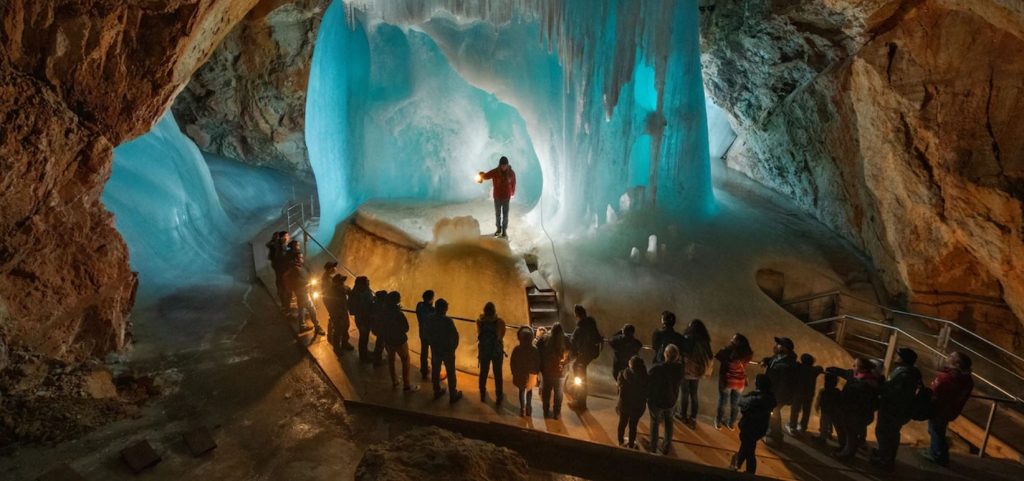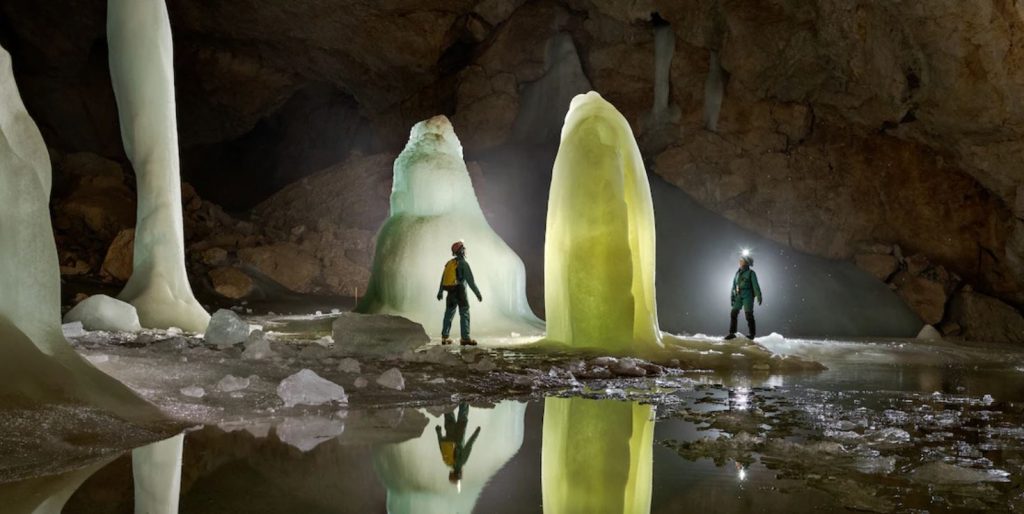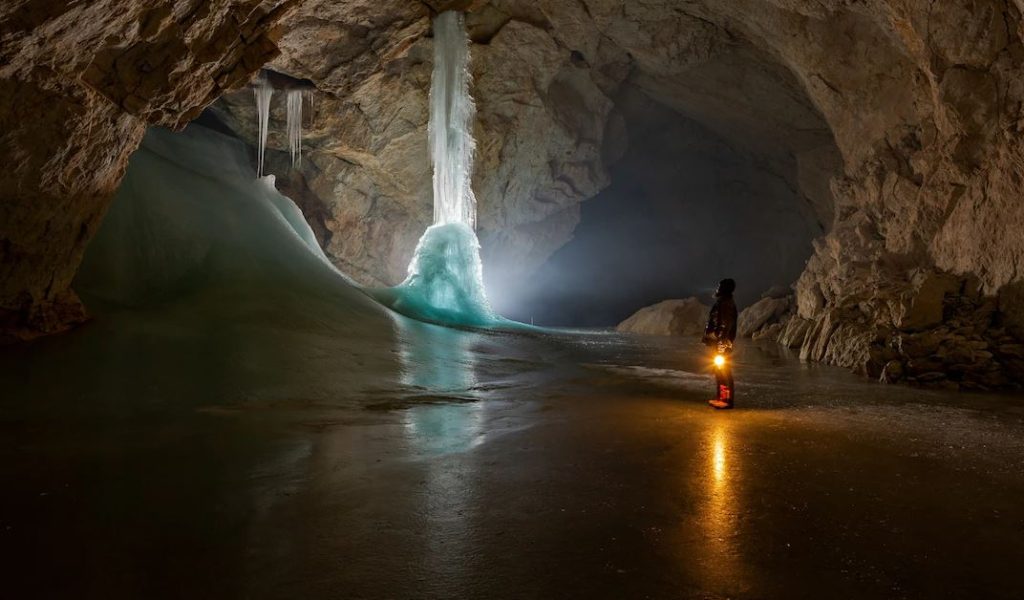For centuries, the Alps’ magical ice cavesthis spectacular underworld recorded the local climate and entranced visitors. Now its fairy-tale features are receding, drip by drip.
As a child, Karoline Zanker had a magical playground. From her home in the quaint Austrian village of Sankt Martin bei Lofer, near Salzburg, she’d hike past a little pilgrimage church and up into the Lofer Mountains, just below the tree line where even hardy larches cease to grow. At an altitude of about 5,200 feet, under the lofty peaks, she’d slip through a narrow portal in the limestone and crawl right inside the mountain. Prax ice cave, she says, was just like a fairy tale.
Ice poured down from the cave ceiling like frozen waterfalls, and towers of it rose from the floors of corridors hundreds of yards long. Ice crystals and icicles glittered like precious gems on the walls.
“It was incredibly marvelous,” recalls Zanker, now 48 and working as a cave guide.
That fairy tale is forever lost because of climate change. Last fall, I crawled, climbed, and wriggled through Prax ice cave for hours, directing my headlamp into the farthest nooks, hoping to spot at least a remnant of what had captivated little Karoline all those years ago. But the thermometer showed about 3 degrees Celsius (37.4° Fahrenheit). Even in the most expansive gallery, there wasn’t a crystal of ice to be found.
“It might be time to take the ‘ice’ out of the cave’s official name,” Zanker says.
Caves form most often in limestone and dolomite—rocks that are particularly dissolvable. Over hundreds of thousands of years, water seeping down from the surface washes out shafts and branching corridors and cavernous rooms that may be large enough to hide rivers and lakes. Minerals sometimes precipitate out of the water that drips into the caves, forming stalactites that hang from the ceiling and stalagmites rising from the floor.
Stretches of the Alps are rich in such caves—and some are cold enough for ice to grow inside instead of stone. No one knows exactly how many ice caves there are, but they undoubtedly are more numerous here than anywhere else: About 1,200 have been found in Austria alone, and several hundred more in northeastern Italy.

Some are just open pits that trap colder, heavier air at the bottom. In others, a difference in elevation between entrance and exit points creates a powerful chimney effect: In winter, when outside temperatures drop well below those inside, the warmer, more buoyant air in the cave begins to rise and escape through higher-up exits, sucking cold, fresh air into the lower-lying entrance points. That chills the cave. In summer, the airstream is reversed: Warm air, sucked in at the top, is chilled by the rock as it descends, and cold air blows out through the lower entrance. The chimney effect usually keeps the lower sections of the cave, where perennial ice can be found, at a relatively constant low temperature year-round.
When that temperature is cold enough, water dripping into the cave freezes into mesmerizing, ever changing shapes. Icicles many feet long or wide festoon the ceiling. Thick ice sheets cascade down the walls. On the floor, the slow drip can gradually build ice cones several floors high or enormous rinks that seal off entire shafts. In some caves the oldest ice dates back thousands of years.

Superstitious ancestors avoided such places, believing that the cold air blowing out of them could only be the devil’s breath. Others took a more pragmatic approach and used them as natural refrigerators or even to ice-skate. A few simply came to admire their beauty and sketched them for early science journals.
It would be impossible today to find the formations depicted in such early drawings; too much of the ice has melted. In the process, we’re losing not just one of the planet’s great wonders but also a clue to its history, says paleoclimatologist Aurel Persoiu of Romania’s Emil Racovita Institute of Speleology. “These ice caves are preserving the memory of past climate,” he says—much like deep ocean sediments or the ice from polar glaciers.
In Scărişoara Cave in Romania’s Apuseni Mountains, Persoiu has been climbing down a 150-foot-deep shaft to reach a perennial ice block with a surface the size of seven basketball courts. Carbon-dating bat guano or plant matter trapped inside the ice tells him when it grew or retreated, as the climate cooled or warmed. He has drilled 80 feet into the block without reaching the bottom, and the oldest ice samples he has taken were more than 10,000 years old. When he got that result, he emailed the lab staff to make sure they hadn’t added a zero.
Chemical analysis of the ice showed that most of the region’s precipitation was from the Atlantic Ocean until about 5,000 years ago, when it pivoted to the eastern Mediterranean Sea. Today another major shift is under way, at Scărişoara and other ice caves in the Alps: Their ice is being decimated by warming air and increased summer rains.
“It’s like pouring warm water on the surface of the ice,” Persoiu says.
In 2018, not far from Scărişoara, he found a promising new cave he hoped to study. “Four years later, when we went back, there was no ice at all,” he says. “It was completely melted.”


At a small clearing east of Austria’s Gesäuse National Park, paleoclimatologist Tanguy Racine zips up his cyan-colored, abrasion-resistant suit and tightens the chin strap on his helmet. It’s fall, and wild raspberries dangle from the bushes around him. Above him, a woodpecker is hammering a fir tree, but he is fixated on the dark, gaping hole at his feet. A small plaque marks it as the entrance to Beilstein ice cave.
Years ago, when Racine, a Frenchman, enrolled as a freshman at Imperial College London, he was compelled by the friendly faces at a booth promoting the caving club to join an expedition to a 20-mile-long cave in Wales. He almost got lost—and that’s what hooked him. “You might only be five meters from the entrance, but it feels like you’re in a different world, away from civilization,” he says. Cavers joke that their hobby is the poor man’s space exploration.

Hands wrapped around a rope, Racine and his colleagues from the University of Innsbruck—lead scientist Christoph Spötl, Gabriella Koltai, and Chloe Snowling—begin to rappel into Beilstein. Gingerly, I follow suit. The woodpecker’s hammering fades away. At the bottom of the shaft, we land on soft soil and lichen-covered rock, and as we continue almost horizontally, darkness envelops us. A few yards in, the spikes on our hiking boots begin to claw and crunch. We’ve hit ice.
A drawing of this cave from 1881 shows a man raising a torch in front of a tsunami-like wall of ice, near ice cones dozens of feet tall. Now all that’s left is the block of ice beneath our feet. Radar surveys show that it might still be more than 30 feet thick.
Along the rock wall, Racine and Snowling spot a gap where the melting ice has pulled away from the wall, creating a small shaft that leads closer to the bottom of the ice block, and deeper in time. The two squeeze down, chest against rock, back against ice, and disappear. An hour later, when they pull themselves back up on ice axes and ropes, they have fresh material to analyze.

“This is research that couldn’t be done previously, and will not be able to be done in 10 years or so, when a lot of the ice is gone,” Racine says.
Meanwhile, Koltai and Spötl have assembled a tall auger and begun drilling into the ice from the top. Bit by bit, they retrieve core samples roughly the diameter of a coffee mug. With a miniature handsaw, Koltai slices out smaller chunks to transport back to the lab. As she drops one chunk into a sampling bag and marks the depth—a little over 12 feet—she beams at a dark bit of organic matter trapped inside the ice, from a blade of grass or a leaf that washed into the cave. Radiocarbon measurements will later show it dates as far back as the 15th century.
Much of this scientific information is doomed; the scientists’ resources are limited, the ice caves many, and the melt rate rapid. Glaciologists already are planning to transport cores from the Alps’ glaciers to Antarctica where, Persoiu says, at least for the foreseeable future, “nothing can go that wrong to melt all the ice.” For cave ice, too, researchers are hoping to store samples somewhere safe, to preserve them for future generations to study.

In the Tennen Mountains I hike up to the largest ice cave on Earth, a place called Eisriesenwelt, or “world of the ice giants.” Less than an hour south of Salzburg, it has been a tourist attraction for a century. A door installed in 1920 at the entrance, at about 5,400 feet, likely has helped keep the cave cold during summers, as has a huge chimney effect: The cave exits on the plateau above are more than 1,500 feet higher. When guide Franz Reinstadler flings the door open on this fall day, the gust of wind almost blows me over.
Inside, we climb 700 steps, passing ice cones and wave-shaped formations, the layers of ice ranging from white to an almost electric blue. Even here, they are deteriorating. A 16-foot-thick figure dubbed the Elephant no longer has a trunk. In summer, Reinstadler patrols the cave with a small-caliber rifle, picking off precariously unstable icicles before they can fall on visitors.
When they ask about the effects of climate change, he answers evasively. “There’s so much we don’t yet understand about the caves, or the ice,” he says. But then he adds: “It’s best to visit it now.” For now, among the ice giants, his breath is still freezing.
